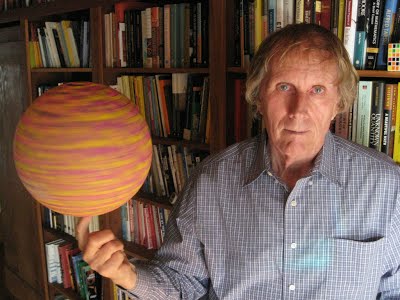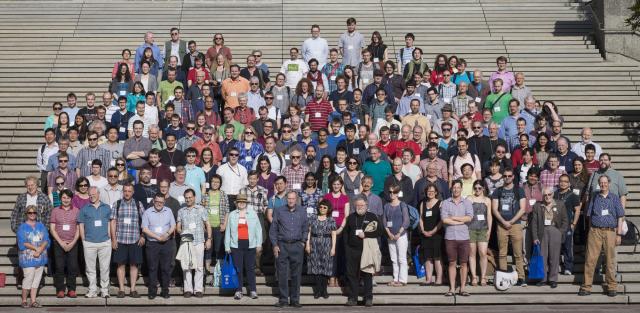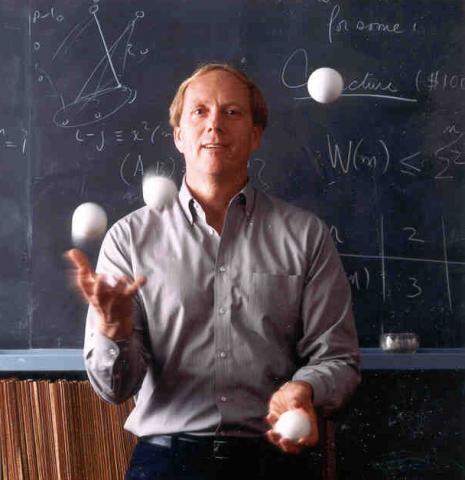
The CSE department is honoring one of its own with a special distinction. The department has established the Ronald L. Graham Chair of Computer Science, named after the current CSE professor, distinguished mathematician, and Chief Scientist in the California Institute for Telecommunications and Information Technology (Calit2). (The Qualcomm Institute is the UC San Diego division of Calit2.)
 The Graham Chair is the first named chair from the department’s endowment built up during the fundraising campaign launched five years ago. The chair announcement is timed to coincide with preparations for the celebration of Graham’s 80th birthday this October, and a series of other events honoring the mathematician-turned-computer science professor, which began in June with “Connections in Discrete Mathematics,” a week-long celebration of Graham's work. The speakers at Simon Fraser University in Vancouver included CSE professors C.K. Cheng and Pavel Pevzner. (Class photo of the conference with Ron and Fan Graham in front row pictured below.)
The Graham Chair is the first named chair from the department’s endowment built up during the fundraising campaign launched five years ago. The chair announcement is timed to coincide with preparations for the celebration of Graham’s 80th birthday this October, and a series of other events honoring the mathematician-turned-computer science professor, which began in June with “Connections in Discrete Mathematics,” a week-long celebration of Graham's work. The speakers at Simon Fraser University in Vancouver included CSE professors C.K. Cheng and Pavel Pevzner. (Class photo of the conference with Ron and Fan Graham in front row pictured below.)
“Ron Graham has led an exemplary life, first at Bell Labs, and later in academia,” said CSE Chair Rajesh Gupta, noting that the chair was originally funded by the anonymous alumnus who donated $18.5 million to the department in 2013. “The donor recognized the role Ron Graham has played and sought to honor him in this way while Graham is still an active faculty member who is revered by his students and colleagues alike. He has devoted the latter part of his life to passing along his knowledge and inspiration to students and younger faculty members.”
The inaugural holder of the Graham Chair is expected to be announced in the fall. The chair will support a faculty member’s research and teaching in areas such as big data, computer systems and cyber-physical systems.
After earning his PhD in Mathematics from UC Berkeley in 1962, Graham began a 37-year career at AT&T Bell Labs, primarily as its director of information sciences. His work on “hard problems” led him to focus on the complexity of routing telephone calls across U.S. time zones for AT&T. Graham was also influential on the development of the Internet, after he explored the creation of a worldwide network of routers with MIT mathematician Tom Leighton. Leighton went on to create Akamai Technologies, which is today believed to be the world's largest, globally-distributed computing platform – and a critical component of the global Internet. (For many years Graham served on Akamai’s board of directors.)
 Following the breakup of AT&T in 1984 and the spinoff of Bell Labs and manufacturing businesses into Lucent Technologies in 1996, Graham became Chief Scientist of the downsized research unit, renamed AT&T Labs. Three years later, in 1999, then-UC San Diego Chancellor Robert Dynes (a former colleague at Bell Labs) invited Graham to join the CSE faculty in the Jacobs School of Engineering. Less than two years later Graham added the title of Chief Scientist in Calit2, the joint UC San Diego-UC Irvine research institute created by the State of California in December 2000.
Following the breakup of AT&T in 1984 and the spinoff of Bell Labs and manufacturing businesses into Lucent Technologies in 1996, Graham became Chief Scientist of the downsized research unit, renamed AT&T Labs. Three years later, in 1999, then-UC San Diego Chancellor Robert Dynes (a former colleague at Bell Labs) invited Graham to join the CSE faculty in the Jacobs School of Engineering. Less than two years later Graham added the title of Chief Scientist in Calit2, the joint UC San Diego-UC Irvine research institute created by the State of California in December 2000.
Graham’s primary role in Calit2 has been as an advisor to the institute’s long-serving director, Larry Smarr, and its governing and advisory boards. “I have relied tremendously on Ron Graham for his personal guidance and input on where to take Calit2 next,” said Smarr. “He has played an active role in discussions about the future of Calit2, and he helped us anticipate the massive impact that the Internet and communications technologies would have on many different disciplines and business sectors.”
Graham’s ability to grasp the big picture and at the same time to break down the components of a problem in order to find a solution made him a born mathematician. At one point the Guinness Book of World Records attributed to Graham the longest number ever used in a mathematical proof (in 1977) – a number so big that there is no known notation – and “Graham’s number” got him featured in Ripley’s Believe It or Not! His long friendship with influential mathematician Paul Erdős also resulted in Graham’s 1979 paper that introduced the concept of an “Erdős number” showing how closely other mathematicians were tied to Erdős based on the number of publications they co-authored with Erdős. Ron Graham’s Erdős number: 1 (reserved for Erdos’s immediate co-authors.) The concept later took hold in Hollywood as the basis of the popular “Six Degrees of Separation” game depicting how close an actor got to appearing in a movie with Kevin Bacon.
Another of Graham’s frequent co-authors is UC San Diego mathematics and computer science professor Fan Chung Graham. They have been married since 1983.
According to the American Mathematical Society, over which Graham once presided, he has been "one of the principal architects of the rapid development worldwide of discrete mathematics in recent years." Graham’s most important mathematics work has been in combinatorics, graph theory, number theory, computational geometry, Ramsey theory (which asserts that complete disorder is impossible), quasi-randomness and scheduling theory. His honors have included the Steele Prize for Lifetime Achievement (in 2003), Euler Medal (1994), Carl Allendorfer Award (1990) and Polya Prize in Combinatorics (1972). He is a Member of the National Academy of Sciences.
 Graham is also known for his wide-ranging passions and hobbies. He speaks fluent Mandarin, and was the table-tennis and bowling champion at Bell Labs. Graham is a past president of the International Juggling Association (pictured at right, in 1986), part of a lifelong interest in juggling, and he put himself through graduate school at UC Berkeley performing in a circus trampoline act. Graham also explored the math behind card and magic tricks in “Magical Mathematics” (Princeton University Press, 2011) – a serious but entertaining book co-authored with Stanford mathematician Persi Diaconis. The first paperback edition is scheduled for this October, and the book won the 2013 Euler Book Prize given by the Mathematical Association of America.
Graham is also known for his wide-ranging passions and hobbies. He speaks fluent Mandarin, and was the table-tennis and bowling champion at Bell Labs. Graham is a past president of the International Juggling Association (pictured at right, in 1986), part of a lifelong interest in juggling, and he put himself through graduate school at UC Berkeley performing in a circus trampoline act. Graham also explored the math behind card and magic tricks in “Magical Mathematics” (Princeton University Press, 2011) – a serious but entertaining book co-authored with Stanford mathematician Persi Diaconis. The first paperback edition is scheduled for this October, and the book won the 2013 Euler Book Prize given by the Mathematical Association of America.
The naming of the new chair is noteworthy because Graham himself holds the oldest endowed chair established at UC San Diego: the Irwin and Joan Jacobs Chair in Information and Computer Science was originally endowed by the Jacobs’ in 1981, after Irwin Jacobs sold his first company Linkabit to M/A-COM (although the first professor to hold the chair was not named until after Jacobs cofounded Qualcomm, Inc., in 1985 and after UC San Diego’s creation of a stand-alone CSE department in 1987).
Graham will also be celebrated at a special event to be held in late January in connection with the Information Theory and Applications Workshop that draws top information theorists from around the world to San Diego, organized by Calit2’s Information Theory and Applications Center (ITA). The roster of distinguished speakers celebrating Graham will include Fields Medal winner Shing-Tung Yau. He will also be featured by the Simons Foundation in its “Science Lives” oral history video series, based on a recent interview with Joe Buhler, who directs the Institute for Defense Analyses’ Center for Communications Research in La Jolla.
Watch a new 20-minute documentary on "The Math & Magic of Ron Graham" by George Csicsery of Zala Films.
June 2015 "Connections in Discrete Mathematics" in Graham's honor.

